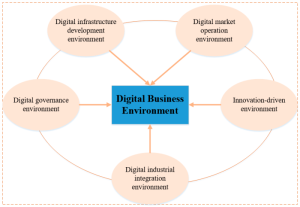
Step into the dynamic world of Business Environment and Economic Factors where every decision, trend, and stability is intertwined in a fascinating dance of influence and impact. Get ready to explore how global economic trends, stability, and decision-making processes shape the business landscape.
Let’s dive into the intricate connections between economic factors and the business environment to uncover the secrets behind successful businesses thriving in today’s ever-changing market.
Business Environment and Economic Factors

Economic factors play a crucial role in shaping the business environment, influencing decision-making processes and overall business operations. These factors have a significant impact on the success and sustainability of businesses across various industries.
Examples of Economic Factors
- Fluctuations in interest rates: Changes in interest rates can affect borrowing costs for businesses, impacting investment decisions and profitability.
- Inflation rates: High inflation rates can erode purchasing power, leading to changes in consumer behavior and pricing strategies.
- Unemployment levels: High unemployment rates can reduce consumer spending, affecting demand for goods and services.
- Exchange rates: Currency fluctuations can impact international trade, affecting export/import activities and revenue streams.
Relationship between Business Environment and Economic Stability
Maintaining economic stability is crucial for creating a conducive business environment. A stable economy with low inflation, low unemployment, and steady growth provides businesses with a predictable environment for planning and decision-making. On the other hand, economic instability can lead to uncertainty, making it challenging for businesses to thrive and grow.
Effects of Global Economic Trends on Local Businesses
Global economic trends, such as trade policies, geopolitical events, and market fluctuations, can have a direct impact on local businesses. For example, changes in international trade agreements can open up new market opportunities or create barriers for local businesses. Additionally, global economic downturns can lead to reduced demand for goods and services, affecting the overall performance of local businesses.
Chemicals and Allied Products
Chemicals and allied products play a crucial role in various industries, serving as essential components in manufacturing, agriculture, healthcare, and consumer goods production. These products encompass a wide range of substances, including industrial chemicals, pharmaceuticals, fertilizers, and cleaning agents.
Contribution to Economic Growth
Chemicals and allied products contribute significantly to economic growth by fueling innovation and driving productivity across different sectors. For example, the pharmaceutical industry relies on chemicals to develop life-saving medications, while the agriculture sector uses fertilizers to enhance crop yields. The manufacturing industry also depends on chemicals for the production of plastics, textiles, and other materials essential for the production of goods.
- Chemicals enable the development of new products and technologies, leading to increased competitiveness and market expansion.
- They create job opportunities and support economic diversification in regions where chemical manufacturing is prominent.
- Chemicals drive exports and trade, contributing to the overall economic prosperity of countries involved in the production and distribution of these products.
Importance of Regulations in the Chemicals Industry
Regulations in the chemicals industry are essential for ensuring the safety of products, protecting the environment, and promoting sustainable business practices. By setting standards for the handling, storage, and disposal of chemicals, regulations help mitigate potential risks to human health and the ecosystem. Compliance with these regulations also fosters consumer trust and confidence in the products being manufactured.
- Regulations promote transparency and accountability in the chemicals industry, encouraging companies to adopt responsible practices that benefit both society and the environment.
- They help prevent pollution and reduce the impact of hazardous substances on the environment, leading to a healthier and more sustainable business environment.
- Regulatory compliance enhances the reputation of companies in the chemicals sector, providing a competitive edge in the global marketplace.
Innovations in Chemicals and Allied Products
Innovations in chemicals and allied products play a vital role in driving economic development by introducing new technologies, processes, and materials that enhance efficiency and sustainability in various industries. From biodegradable plastics to advanced pharmaceutical formulations, these innovations offer solutions to complex challenges and create opportunities for growth and progress.
- Advanced materials developed through chemical innovations improve the performance and durability of consumer products, leading to enhanced user experiences and increased demand.
- Green chemistry initiatives focus on creating environmentally friendly alternatives to traditional chemicals, reducing waste and minimizing environmental impact.
- Research and development in the chemicals sector drive continuous improvement and innovation, paving the way for future advancements and economic growth.
Construction and Maintenance
Construction and maintenance are crucial sectors heavily influenced by economic factors. The demand for new construction projects and the ability to maintain existing infrastructure are directly impacted by the overall economic health of a region.
Impact of Infrastructure Development
Infrastructure development plays a significant role in shaping the business environment. Improved infrastructure, such as new roads, bridges, and public facilities, can attract businesses to a region, leading to increased construction and maintenance activities. On the other hand, lack of investment in infrastructure can hinder business growth and development opportunities.
- Investment in infrastructure projects can create jobs and stimulate economic growth.
- Well-maintained infrastructure can enhance the efficiency of businesses and improve the overall quality of life for residents.
- Infrastructure projects can also have long-term economic benefits by increasing property values and attracting investors.
Adaptation to Economic Fluctuations
Construction and maintenance businesses need to be adaptable to economic fluctuations to survive in a competitive market. During economic downturns, these businesses may experience a decrease in demand for new projects, leading to layoffs and reduced revenues. To adapt, companies may diversify their services, focus on maintenance contracts, or explore new markets.
- Implementing cost-saving measures such as efficient resource management and strategic planning can help construction and maintenance businesses weather economic uncertainties.
- Forming partnerships with government agencies or private investors for funding can provide stability during economic downturns.
- Exploring opportunities in sustainable construction practices can help businesses differentiate themselves in the market and attract environmentally conscious clients.
Sustainable Practices in Construction and Maintenance
Sustainable practices in the construction and maintenance industry focus on reducing environmental impact, promoting energy efficiency, and ensuring long-term durability of structures. These practices not only benefit the environment but also contribute to cost savings and improved reputation for businesses.
- Using eco-friendly materials and technologies, such as recycled building materials and energy-efficient systems, can reduce carbon footprint and operational costs.
- Implementing green building certifications, such as LEED (Leadership in Energy and Environmental Design), can demonstrate a commitment to sustainability and attract environmentally conscious clients.
- Adopting maintenance strategies that prolong the lifespan of structures, such as regular inspections and timely repairs, can reduce the need for costly replacements and minimize waste.
Consumer Goods and Services
Consumer goods and services play a crucial role in the economy, as they are directly impacted by various economic factors and consumer behavior. Understanding the relationship between these factors is essential for businesses to thrive in this competitive market.
Consumer Behavior and Economic Factors
Consumer behavior is greatly influenced by economic factors such as income levels, inflation rates, and employment status. During economic downturns, consumers tend to cut back on discretionary spending and prioritize essential goods and services. On the other hand, during economic booms, consumers may be more willing to splurge on luxury items. Businesses need to adapt their strategies accordingly to cater to changing consumer preferences based on economic conditions.
Consumer Preferences and Business Environment
Consumer preferences play a significant role in shaping the business environment for goods and services. Businesses need to conduct market research to understand what drives consumer choices and tailor their products and marketing strategies accordingly. For example, the rise of health-conscious consumers has led to an increase in demand for organic and natural products, forcing businesses to adjust their offerings to meet these preferences.
Technological Advancements in Consumer Goods
Technological advancements have revolutionized the consumer goods and services sector, offering new ways to engage with customers and improve product offerings. From e-commerce platforms to personalized recommendations based on consumer data, technology has transformed the way businesses interact with consumers. Companies that embrace technological innovations are better positioned to meet the evolving needs of their target market and stay ahead of the competition.
Successful Marketing Strategies in Consumer Goods Industry
Successful marketing strategies in the consumer goods industry often revolve around creating a strong brand identity, engaging with consumers through social media platforms, and leveraging influencer partnerships. Companies that can effectively communicate their brand values and resonate with their target audience are more likely to succeed in a crowded market. Additionally, offering promotions, discounts, and limited-time offers can help drive consumer interest and boost sales in the competitive consumer goods industry.
Business Energy

Energy resources play a crucial role in the business environment, powering operations, manufacturing processes, and overall productivity. The availability and cost of energy directly impact the profitability and sustainability of businesses across various industries.
Significance of Energy Resources
Energy costs are a significant expense for businesses, affecting their bottom line and competitiveness in the market. Fluctuations in energy prices can impact profit margins and operational efficiency, leading to strategic decisions to mitigate these risks.
Impact of Energy Costs
- Businesses often implement energy-efficient practices to reduce costs and improve sustainability. This includes investing in energy-saving technologies, optimizing production processes, and exploring alternative energy sources.
- Higher energy costs can result in increased operational expenses, affecting pricing strategies, supply chain management, and overall financial performance.
- Businesses may face challenges in forecasting energy expenses, leading to budget constraints and the need for strategic planning to manage these uncertainties.
Role of Renewable Energy
Renewable energy sources such as solar, wind, and hydropower are increasingly adopted by businesses to reduce their carbon footprint and dependence on fossil fuels. Incorporating renewable energy into operations promotes sustainability and aligns with environmental regulations and consumer preferences.
Energy-Efficient Initiatives
- Implementing energy-efficient lighting systems, HVAC upgrades, and insulation improvements to reduce electricity consumption and lower utility bills.
- Optimizing transportation logistics and fleet management to minimize fuel consumption and emissions, contributing to cost savings and environmental benefits.
- Leveraging smart technologies and automation to monitor and control energy usage in real-time, enabling proactive measures to optimize efficiency and reduce waste.
Wrap-Up
As we conclude our journey through the realm of Business Environment and Economic Factors, remember that understanding the intricacies of economic impact and stability is key to navigating the complex landscape of modern business. Embrace the challenges, adapt to the trends, and watch your business flourish amidst the ever-evolving economic landscape.
FAQ
How do economic factors influence the business environment?
Economic factors such as inflation, interest rates, and consumer confidence can impact business operations, pricing strategies, and overall performance.
What is the relationship between business environment and economic stability?
The business environment is influenced by economic stability, which affects investment decisions, market growth, and overall business confidence.
How do global economic trends impact local businesses?
Global economic trends can influence local businesses through changes in export/import policies, currency fluctuations, and market demands.





